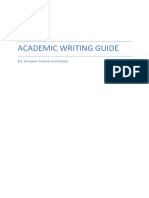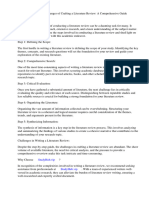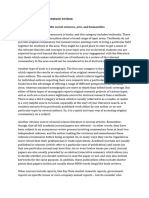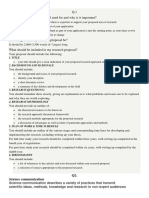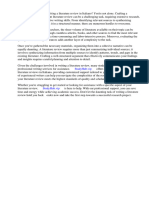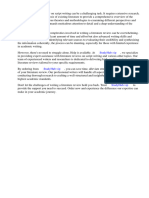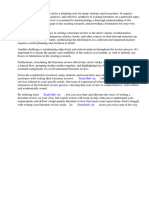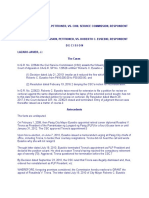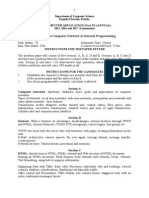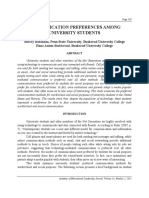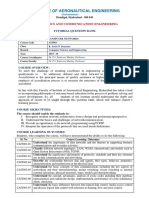Center For Industrial Technology and Enterprise: Stages
Center For Industrial Technology and Enterprise: Stages
Uploaded by
Maria Cherrylen Castor QuijadaCopyright:
Available Formats
Center For Industrial Technology and Enterprise: Stages
Center For Industrial Technology and Enterprise: Stages
Uploaded by
Maria Cherrylen Castor QuijadaOriginal Description:
Original Title
Copyright
Available Formats
Share this document
Did you find this document useful?
Is this content inappropriate?
Copyright:
Available Formats
Center For Industrial Technology and Enterprise: Stages
Center For Industrial Technology and Enterprise: Stages
Uploaded by
Maria Cherrylen Castor QuijadaCopyright:
Available Formats
Center for Industrial Technology and Enterprise
San Jose, Cebu City
DLP LEARNING ACTIVITY SHEET 6
Subject Title
Type of Activity
Activity Title
Duration
Learning Target/s
:
:
:
:
:
Reference/s
Project Study 392
Concept Notes/Exercise
Coping with the research literature
2 hours
To determine the different stages and purposes of research literature
and classify the various materials for reading.
Loraine Blaxter, Christina Hughes and Malcolm Tight (2010), How to
Research, 4th Edition, Open University Press McGraw-Hill Education
McGraw-Hill House Shoppenhangers Road Maidenhead Berkshire England
SL6 2QL
I. CONCEPT DIGEST
Coping with the research literature
To the novice researcher, it can seem as if there is so much that needs reading, and that it is so difcult to
get on top of or make sense of it. More experienced researchers you may or may not be relieved to know
can have much the same concerns. But the new researcher may feel overwhelmed by the magnitude of
these demands for quite a long time.
Reading at different stages and for different purposes
Stages
At the beginning of your research, in order to check what other research has been done, to focus
your ideas, shape your hypotheses and explore the context for your project.
During your research, to keep you interested and up to date with develop- ments, to help you
better understand the methods you are using and the eld you are researching, and as a source of
data.
After your research, to see what impact your own work has had and to help you develop ideas
for further research projects.
Purposes
Accounts of research on similar topics to your own.
Accounts of research methods being applied in ways which are similar to your own plans.
Accounts of the context relating to your project.
To protect against duplication and enrich your arguments.
How does the researcher get to grips with this?
The variety of literature. There are so many kinds of literature (e.g. textbooks, journals,
magazines, newspapers, policy documents, academic papers, conference papers, internet
materials, internal reports, novels, etc.) which may be relevant.
1
QF-CAS-05-009
Rev:00
How does the researcher use this range of sources?
Lack of boundaries. Unless a project is very tightly dened, it may be impossible to judge
which areas of the literature are relevant.
How does the researcher avoid reading too widely or aimlessly?
Conicting arguments. As soon as you start reading, you are likely to be confronted by different
opinions, arguments and interpretations. It may seem that no two writers agree about even the
most basic issues.
How does the researcher assess these arguments, and place themself within them?
Hint: If you nd very conicting arguments in your reading around, you may well have
identied an issue or debate which would be worth exploring in your research project.
Basic reading strategies
Where to read
The obvious place to read at least, up until the last decade or so may seem to be the library,
particularly if you are doing a research project in an academic setting. Libraries come in different
guises. They may be wide-ranging or spe- cialized resources, general or academic in function, for
reference only or available for borrowing. This last distinction highlights a critical point: that of
access. While public libraries are available to everyone, and university libraries normally allow
access to all bona de researchers, some may impose restrictions on borrowing or charge fees, and
others may prohibit access altogether.
The other obvious place to read, nowadays, is on your computer, making use of some of the vast
range of materials available through the internet. Compared to libraries, the material available on
the internet is much more variable in quality. You do, of course, need to have, or have access to, a
computer and internet connection. Given this, access is easy, though at times it may be frustrating
and can be expensive.
What to read
The kinds of things you might read could include:
Books: of all kinds.
Journals: local, national and international, home and overseas, practitioner oriented or research
based, popular and academic, and abstracting journals.
Reports: produced by institutions or organizations of different kinds, including employers,
representative associations, political parties, trade unions, voluntary bodies, community groups,
central and local government, and international bodies.
Popular media: the daily and weekly press, magazines, radio and television broadcasts.
Online materials: including both textbook and journal materials as well as discussion groups
and websites.
Memos, minutes, internal reports: produced by organizations you are studying, or which are
relevant to your research topic.
2
QF-CAS-05-009
Rev:00
Letters, diaries: and other personal documents produced by individuals of interest.
In using these different kinds of written sources, it will be useful to bear in mind a number of
other distinctions between types of material for reading:
Published and unpublished literature. Much that is of relevance to your research, perhaps
because it is a relatively new eld, may not be published. Unpublished material (e.g. committee
minutes), though more difcult to access as an outsider, may be of critical importance to your
research.
Contemporary and classic works. While it is important to be as up to date as possible, this does
not mean that you should ignore older materials. There may be key classic texts in your
discipline which you should refer to. Or you may nd that much the same issues which you are
addressing have been tackled by others quite some time ago.
Introductory and overview texts. All disciplines have produced one or more basic texts which
summarize their development and current state of thinking. Typically designed for sixth-form or
undergraduate audiences, these texts can be very useful means for reading quickly into a new or
unfamiliar subject area, or for refreshing your understanding.
Edited collections and literature reviews. These may also be of particular use to you when
starting your research, particularly if they have been recently published. Edited collections can
be an excellent introduction to a given topic. Literature reviews may be invaluable as well, but
do not place too much reliance on their opinions or selection. Wherever possible, refer to the
original materials as well so that you can form your own views.
Methodological and confessional accounts. In addition to reading books and papers which relate
directly to the issues you are researching, you should also consider reading material on the
approaches, techniques and methods you are using in your research project. These may focus on
the methods themselves or on other peoples experience of applying them.
Finally, in your reading you should be aware of the extent to which texts present and make use of
original data. A common distinction made is that between primary, secondary and tertiary sources. Primary
sources mainly consist of original data, while secondary sources comment on and interpret data, and
tertiary sources (e.g. textbooks) offer summaries of knowledge in a particular area. You would be unwise to
restrict your reading mainly to tertiary sources, though these can be valuable as an initial guide.
II. EXERCISES/QUESTIONS/DRILLS
1. Explain the stages and purposes of the reading in course of the project study making. (5pts.)
2. Describe various sources reading materials. (5pts.)
3
QF-CAS-05-009
Rev:00
You might also like
- Prof Kramoko 22-23 Practical MethodologyDocument12 pagesProf Kramoko 22-23 Practical MethodologyDarah BadNo ratings yet
- How Long Should A PHD Thesis Literature Review BeDocument6 pagesHow Long Should A PHD Thesis Literature Review BeafmzzulfmzbxetNo ratings yet
- Steps of Conducting Literature ReviewDocument5 pagesSteps of Conducting Literature Reviewafdtunqho100% (1)
- Eucs Academic Writing GuideDocument14 pagesEucs Academic Writing Guidemiddle centerNo ratings yet
- PR2 Topic 1 2Document6 pagesPR2 Topic 1 2John Masao LogronoNo ratings yet
- Background Study and Literature ReviewDocument7 pagesBackground Study and Literature Reviewaflrrefsn100% (1)
- Steps Conducting Literature ReviewDocument5 pagesSteps Conducting Literature Reviewc5rz37qv100% (1)
- University of Bayreuth. Guide To Academic Writing. 2019Document13 pagesUniversity of Bayreuth. Guide To Academic Writing. 2019asbrakeNo ratings yet
- Developing Your Literature Review (Session 3 Reading 2)Document13 pagesDeveloping Your Literature Review (Session 3 Reading 2)findlotteNo ratings yet
- How To Identify A Research ProblemDocument9 pagesHow To Identify A Research ProblemJananee RajagopalanNo ratings yet
- Purpose of Literature Review in Research MethodsDocument5 pagesPurpose of Literature Review in Research Methodsea884b2kNo ratings yet
- Literature Review Articles SampleDocument8 pagesLiterature Review Articles Samplec5p64m3t100% (1)
- Literature Review NiceDocument8 pagesLiterature Review Niceea0bvc3s100% (1)
- Best Way To Write A Literature ReviewDocument5 pagesBest Way To Write A Literature Reviewaflskdwol100% (1)
- How To Do A Literature Review For A DissertationDocument7 pagesHow To Do A Literature Review For A Dissertationafmzethlgpqoyb100% (1)
- How To Literature Review DissertationDocument5 pagesHow To Literature Review Dissertationendulrave1986100% (1)
- Steps of Literature ReviewDocument6 pagesSteps of Literature Reviewafmzvulgktflda100% (1)
- Reading For Research: Riset Teknologi InformasiDocument21 pagesReading For Research: Riset Teknologi InformasiMuhammad Hasan FikkriNo ratings yet
- Literature Review On Science EducationDocument7 pagesLiterature Review On Science Educationc5qz47sm100% (1)
- Success in ResaearchDocument8 pagesSuccess in ResaearchrpkcetNo ratings yet
- 2-Search For SourcesDocument18 pages2-Search For Sourcesatomixgaming001No ratings yet
- Steps in Literature ReviewDocument5 pagesSteps in Literature Reviewcdkxbcrif100% (1)
- Module 11Document7 pagesModule 11Jerome BautistaNo ratings yet
- Describe Critical Literature Review ProcessDocument8 pagesDescribe Critical Literature Review Processc5rz37qv100% (1)
- Literature Review Age of SourcesDocument6 pagesLiterature Review Age of Sourcesafmzrxbdfadmdq100% (1)
- II. Literature ReviewDocument6 pagesII. Literature Reviewc5rga5h2100% (1)
- Guide To Academic Writing 2015Document14 pagesGuide To Academic Writing 2015Joking ReaperNo ratings yet
- What Tense To Write Literature ReviewDocument4 pagesWhat Tense To Write Literature Reviewafdtywgdu100% (1)
- What Is A Literature Review and What Is Its Purpose in A Research PaperDocument6 pagesWhat Is A Literature Review and What Is Its Purpose in A Research Paperea1yw8dxNo ratings yet
- Literature Review NuigDocument7 pagesLiterature Review Nuigbeqfkirif100% (1)
- How Long Literature Review Should Be For A DissertationDocument7 pagesHow Long Literature Review Should Be For A DissertationHelpOnWritingAPaperSingaporeNo ratings yet
- BE&RWDocument9 pagesBE&RWMian Adeel JeeNo ratings yet
- How Long Should Be Literature Review For DissertationDocument4 pagesHow Long Should Be Literature Review For Dissertationc5jbmre7No ratings yet
- Steps in Writing A Good Literature ReviewDocument4 pagesSteps in Writing A Good Literature Reviewafmzvadyiaedla100% (1)
- Background and Literature ReviewDocument7 pagesBackground and Literature Reviewc5qv9jtn100% (1)
- What Is The Important of Literature Review in ResearchDocument5 pagesWhat Is The Important of Literature Review in ResearchafmzuiqllaaabjNo ratings yet
- How To Write Literature Review in A Research ReportDocument8 pagesHow To Write Literature Review in A Research ReportafdtfngqbNo ratings yet
- How To Write A Research PieceDocument3 pagesHow To Write A Research PieceVero EnriquezNo ratings yet
- Literature Review - 2024Document10 pagesLiterature Review - 2024Pratima MandadiNo ratings yet
- Literature Review in ItalianoDocument7 pagesLiterature Review in Italianoe9xsjk8h100% (1)
- Framework of Literature ReviewDocument8 pagesFramework of Literature Reviewc5eakf6z100% (1)
- Doing A Literature ReviewDocument9 pagesDoing A Literature ReviewGHRIEB100% (2)
- Literature Review On Script WritingDocument8 pagesLiterature Review On Script Writingafmzbdjmjocdtm100% (1)
- Why Should I Do A Literature ReviewDocument8 pagesWhy Should I Do A Literature Reviewaflsbdfoj100% (1)
- Why Is A Literature Review So Important in Academic ResearchDocument4 pagesWhy Is A Literature Review So Important in Academic Researchea7e9pm9No ratings yet
- Sample Introduction For Review of Related Literature and StudiesDocument7 pagesSample Introduction For Review of Related Literature and StudiesaiqbzprifNo ratings yet
- How To Make Literature ReviewDocument4 pagesHow To Make Literature Reviewafdtsdece100% (1)
- Write Methods Section Literature ReviewDocument7 pagesWrite Methods Section Literature Reviewea0xbk19100% (1)
- What A Literature Review EntailsDocument4 pagesWhat A Literature Review Entailsafmzmajcevielt100% (1)
- How To Write A Literature Review in A Research ProjectDocument7 pagesHow To Write A Literature Review in A Research Projectc5se0nswNo ratings yet
- What Is Literature Review When Writing A ProjectDocument6 pagesWhat Is Literature Review When Writing A Projectafdtzgcer100% (1)
- Typical Literature Review LengthDocument5 pagesTypical Literature Review Lengthaflsldrzy100% (1)
- Model Literature Review DissertationDocument8 pagesModel Literature Review Dissertationaiqbzprif100% (1)
- WMG Literature ReviewDocument6 pagesWMG Literature Reviewaflsmmmgx100% (1)
- Key Characteristics of A Good Literature Review in ResearchDocument5 pagesKey Characteristics of A Good Literature Review in ResearchafmzsbnbobbgkeNo ratings yet
- Literature Review Example IntroductionDocument5 pagesLiterature Review Example Introductionc5p9zbep100% (1)
- How To Write My Literature ReviewDocument8 pagesHow To Write My Literature Reviewfrvkuhrif100% (1)
- How to Successfully Deal with Your Dissertation DataFrom EverandHow to Successfully Deal with Your Dissertation DataNo ratings yet
- Writing Your Dissertation Literature Review: A Step-by-Step GuideFrom EverandWriting Your Dissertation Literature Review: A Step-by-Step GuideRating: 4.5 out of 5 stars4.5/5 (23)
- Eusebio Vs CSCDocument7 pagesEusebio Vs CSCMaria Cherrylen Castor QuijadaNo ratings yet
- G.R. No. 223099 PEOPLE OF THE PHILIPPINES, Plaintiff-Appellee LINO ALEJANDRO y PIMENTEL, Accused-Appellant Decision Tijam, J.Document5 pagesG.R. No. 223099 PEOPLE OF THE PHILIPPINES, Plaintiff-Appellee LINO ALEJANDRO y PIMENTEL, Accused-Appellant Decision Tijam, J.Maria Cherrylen Castor QuijadaNo ratings yet
- Rural Bank Vs EspeletaDocument11 pagesRural Bank Vs EspeletaMaria Cherrylen Castor QuijadaNo ratings yet
- ERAÑA Vs VERADocument2 pagesERAÑA Vs VERAMaria Cherrylen Castor QuijadaNo ratings yet
- People Vs TanDocument13 pagesPeople Vs TanMaria Cherrylen Castor QuijadaNo ratings yet
- People Vs JachoDocument12 pagesPeople Vs JachoMaria Cherrylen Castor QuijadaNo ratings yet
- Vda de Perez Vs ToleteDocument9 pagesVda de Perez Vs ToleteMaria Cherrylen Castor QuijadaNo ratings yet
- Case Digest: Dante O. Casibang vs. Honorable Narciso A. AquinoDocument3 pagesCase Digest: Dante O. Casibang vs. Honorable Narciso A. AquinoMaria Cherrylen Castor Quijada100% (1)
- Compromises FulltextDocument52 pagesCompromises FulltextMaria Cherrylen Castor QuijadaNo ratings yet
- Brillante v. CA (2004) Digest + Full TextDocument21 pagesBrillante v. CA (2004) Digest + Full TextMaria Cherrylen Castor QuijadaNo ratings yet
- Vita Vs MontananoDocument8 pagesVita Vs MontananoMaria Cherrylen Castor QuijadaNo ratings yet
- The Consolidated Bank Vs IACDocument7 pagesThe Consolidated Bank Vs IACMaria Cherrylen Castor QuijadaNo ratings yet
- Unify OpenScape Business Administration GuideDocument1,652 pagesUnify OpenScape Business Administration GuideLorenzo BellucciNo ratings yet
- Eng2a UsermanualDocument33 pagesEng2a UsermanualfwillyNo ratings yet
- Report by Team 11 Leader TASK 13 17th AugDocument46 pagesReport by Team 11 Leader TASK 13 17th AuganjusnairNo ratings yet
- Operator Manual: Service ToolDocument80 pagesOperator Manual: Service ToolMiqueias FerreiraNo ratings yet
- Class 7 Chapter 4 Solved AssessmenpdfDocument5 pagesClass 7 Chapter 4 Solved AssessmenpdfSikharNo ratings yet
- Thailand Technology Internet - GS Research - 20180706Document50 pagesThailand Technology Internet - GS Research - 20180706AyushNo ratings yet
- Digital Locker Authorized Partner API Specification v1.11Document44 pagesDigital Locker Authorized Partner API Specification v1.11kkNo ratings yet
- A Brief Study On Digitalization of SBI Banks in KohimaDocument21 pagesA Brief Study On Digitalization of SBI Banks in Kohimaguruprasad.angulNo ratings yet
- Lesson PlanDocument2 pagesLesson PlanSaberAli100% (1)
- Form C5Document1 pageForm C5penusilaNo ratings yet
- Pengiraan Ip Address Muhamad Alfeqri Shah Bin ShahuriDocument15 pagesPengiraan Ip Address Muhamad Alfeqri Shah Bin ShahuriAlfeqri ShahNo ratings yet
- Subject - Computer Application B.A. Part-III (Annual)Document4 pagesSubject - Computer Application B.A. Part-III (Annual)Harpreet KaurNo ratings yet
- Home Manage Services Products Downloads Knowledge ResourcesDocument2 pagesHome Manage Services Products Downloads Knowledge ResourcesShrinivas DasariNo ratings yet
- GC 2024 05 16Document20 pagesGC 2024 05 16malepeclaudia4No ratings yet
- Communication Preferences Among University StudentsDocument1 pageCommunication Preferences Among University StudentsAhtisham UlhaqNo ratings yet
- E MarketingDocument60 pagesE MarketingRasika Sameera SampathNo ratings yet
- Privacy in The Era of TechnologyDocument4 pagesPrivacy in The Era of TechnologyLetiiimpNo ratings yet
- Ie Tab For AndroidDocument2 pagesIe Tab For AndroidshofiyullohNo ratings yet
- PROCESS - Software ProcessDocument12 pagesPROCESS - Software ProcessShih MargaritaNo ratings yet
- Certified Network Security Specialist CNSS QuestionsDocument14 pagesCertified Network Security Specialist CNSS QuestionsKaroNo ratings yet
- Servicio Nacional de Aprendizaje Sena Worksheet: Worksheet - Simple Past "History of Telecommunication"Document1 pageServicio Nacional de Aprendizaje Sena Worksheet: Worksheet - Simple Past "History of Telecommunication"aldemar ruizNo ratings yet
- Unit 7 Neural and Social NetworksDocument29 pagesUnit 7 Neural and Social NetworksAngel Mae IturiagaNo ratings yet
- Challenge of Five Nines Reliability in Voip: AbstractDocument7 pagesChallenge of Five Nines Reliability in Voip: AbstractVaibhav TankhaNo ratings yet
- Thi Tuyển Sinh Tiếng Anh Lớp 10Document23 pagesThi Tuyển Sinh Tiếng Anh Lớp 10nguyenanhmai100% (1)
- SSG III Product Data Sheet - r1 - 03Document2 pagesSSG III Product Data Sheet - r1 - 03subin071784No ratings yet
- Dora Fairytale AdventureDocument14 pagesDora Fairytale AdventureLuv MusixNo ratings yet
- MCS-051 Solved AssignmentsDocument37 pagesMCS-051 Solved AssignmentsAbhijit MalakarNo ratings yet
- Quick Scan Features Setup Guide: Xerox Workcentre 5222/5225/5230Document14 pagesQuick Scan Features Setup Guide: Xerox Workcentre 5222/5225/5230Cristian BobaruNo ratings yet
- CN QB 18-12-18 - 0Document8 pagesCN QB 18-12-18 - 0VigneshNo ratings yet
- Packet Trace1Document3 pagesPacket Trace1Nadia Cruz SantiagoNo ratings yet



